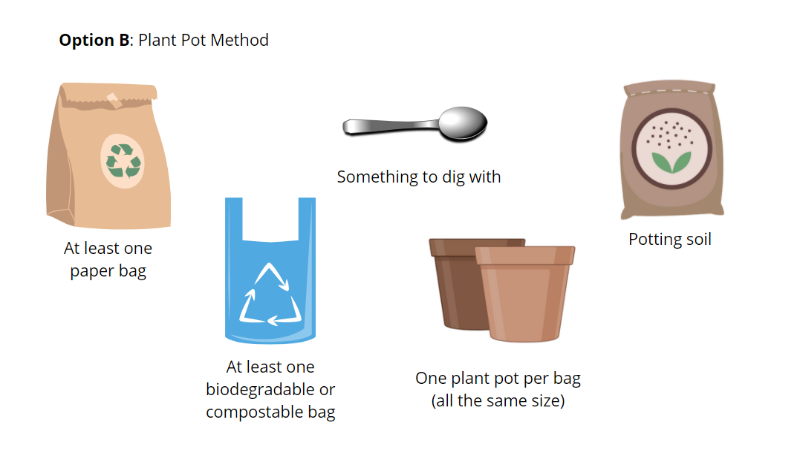-(14).png)
Women in Chemistry: Making the Difference
The STEM Response Team hosted the second challenge in the "Making the Difference" program in collaboration with The Royal Society of Chemistry and the University of Oxford. 'Women in Chemistry: Making the Difference' is a multi-university project providing the opportunity for girls aged 10-14 to engage in creative and enjoyable practical challenges linked to current chemical sciences research at UK universities.
Each month a challenge was shared, along with accompanying resources to explain the research on which the challenge is based. The girls taking part had the opportunity to connect with the female researchers who designed and set the challenge via online meetings each month, ask questions about the practical work, the research on which it is based, as well as about life as a female chemist.
Our challenge, 'Dig It Up', will allow participants to investigate the degradation of different biodegradable and compostable bags from popular supermarkets.
Dig It Up!
This challenge will provide the participants with a greater understanding of the differences difference between "degradable", "biodegradable", and "compostable", increase their knowledge of current environmental issues and how individual choices can contribute towards plastic pollution, and encourage thoughtful thinking/purchasing for the future.
Equipment needed:
• At least one paper bag
• At least one biodegradable plastic bag
• Digging Items (trowel, spoon, etc)
• Option A: A place to bury them in your garden
• Option B: One plant pot per bag (ensure the same size pots are used for each bag)
• Option B: Potting soil (Wilko’s 8L Indoor and outdoor: £1.50)


Suitable Bags:
✓ Morrison’s paper bag: 20p
✓ Aldi Biodegradable carrier bag: 6p
✓ Co-op Compostable carrier bag: 5p
✓ Greggs small paper sleeve: Free
✓ Primark small paper bag: Free
✕ Asda Bag for Life: 20p
✕ Sainsbury's Bag for Life (made from 100% recycled): 30p
✕ Lidl Bag for Life: 9p
Plant Pot Suggestions:
• Homebase 11cm Terracotta: £1.25
• Homebase 23cm Terracotta: £3
• Homebase 13cm Plastic Pack of 5: £2.25 (Please reuse after the experiment to plant flowers or herbs)
Part 1: Bury It Down!
1. Gather your bags (at least one paper and one biodegradable) and choose a spot to bury them. If you are using plant pots, choose a space not undercover so that the rain can reach them.
2. Dig your soil! (A) If you are burying the bags in your garden, make sure they are quite deep so that they won’t come loose and blow away. It’s easier to use gardening tools, such as a trowel. (B) If you are using plant pots, put a layer of soil in the pot first, so your bag sits in the middle of the pot.
3. Cover your bags with soil so they are completely buried.
4. Wait and let nature do its thing!
-800x450.png)
1. Grab your gardening gloves and get messy. Dig up your bags during the week commencing the 15th March – this will be the halfway point of the project.
2. Inspect your bags for any kind of degradation. What does it look like? Is it mushy? Has it got any holes? Has it changed in colour? Note any changes down in your notebook.
3. Bury the same bags back in their original place with the same soil.
4. Wait and let nature do its thing!
5. Dig your bags up again for the final time at the end of March.
6. Inspect your bags once again for any degradation and jot them down in your notebook.
7. Using your data, decide how well each bag is at decomposing, and compare which bag is best and which is worst.
-800x450.png)
1. Using your results, identify which bag is best for degrading.
2. Share your experiment findings with your friends and teachers! Start a discussion about the different types of bags, and how they are disposed of (and how quickly or long this takes).
3. OPTIONAL: Biodegradable and compostable bags take a long time to degrade fully. If you wish to continue to project, bury your bags once again and check on them after 6 months, and then again after 12 months.

1. Work scientifically and create a hypothesis. What do you think will happen with the bags in your experiment?
2. Do you think burying the bags outside vs burying the bags in a plant pot would affect the degradation process?
3. What biotic and abiotic factors are needed to degrade compostable items naturally?
4. After digging up and observing your bags, estimate how long do you think total degradation would take.
5. Do you think using biodegradable and compostable bags when shopping is a good idea? Could you think of any alternatives?
6. Which supermarket provides the most eco-friendly shopping bags?


/prod01/wlvacuk/media/departments/digital-content-and-communications/images-18-19/iStock-163641275.jpg)
/prod01/wlvacuk/media/departments/digital-content-and-communications/images-2024/250630-SciFest-1-group-photo-resized-800x450.png)
/prod01/wlvacuk/media/departments/digital-content-and-communications/images-18-19/210818-Iza-and-Mattia-Resized.jpg)
/prod01/wlvacuk/media/departments/digital-content-and-communications/images/Maria-Serria-(teaser-image).jpg)
/prod01/wlvacuk/media/departments/digital-content-and-communications/images-2024/241014-Cyber4ME-Project-Resized.jpg)
/prod01/wlvacuk/media/departments/digital-content-and-communications/images-18-19/210705-bric_LAND_ATTIC_v2_resized.jpg)
.png)
